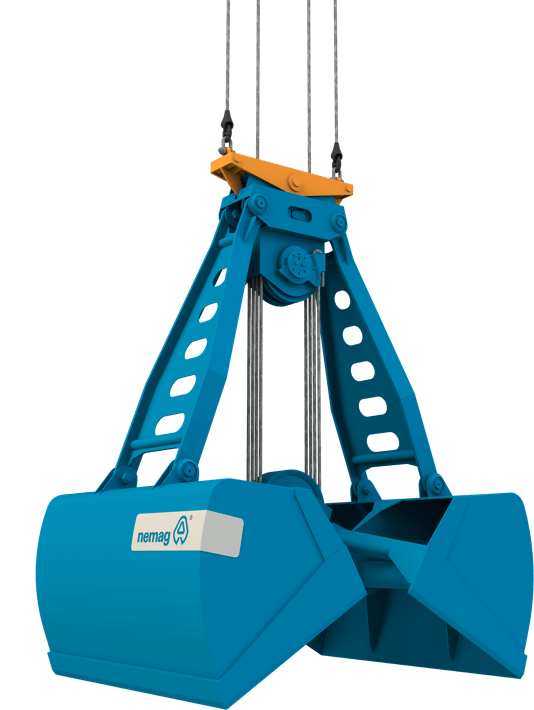Transshipment plays a big role in the seamless operation of the global supply chain, enabling bulk goods to reach their final destinations through strategic intermediate stops. However, the process is filled with operational, technical, and financial challenges, from avoiding port congestion and demurrage costs to maintaining operations under harsh sea conditions and navigating market pressures.
In this article we dive into these challenges and discuss optimization strategies that are essential for enhancing the efficiency and cost-effectiveness of transshipment operations. We illustrate how strategic practices and the right equipment choices, specifically in crane and grab technology, can significantly improve productivity even in geographically challenging conditions.
A good example of a transshipment situation is in Sierra Leone, West Africa, where SMT Shipping has achieved significant transshipment advancements. This region presents a unique challenge due to its shallow shores, extending 10 to 20 meters in depth for up to 10 miles. To be profitable, you will have to ship your cargo with colossal ore carriers. Read the full case study to discover how SMT Shipping has overcome these challenges and boosted their productivity by 25%.
Table of contents
1. What is the definition of transhipment?
2. Reasons for transshipment
3. Trends and challenges
4. The best crane and grab for loading and unloading cargo ships
5. How to improve your transshipment
6. Navigating the future of transshipment with strategic insights
What is the definition of transshipment?
Transshipment refers to the process where goods or dry bulk cargo are transported to an intermediate destination before reaching their final destination. This logistical strategy serves various purposes, including the consolidation of multiple smaller shipments into a single larger one, enhancing efficiency and reducing transportation costs. Conversely, large consolidated shipments can also be divided into smaller packages (deconsolidation).
High-performance transshipment is typically carried out at onshore or offshore transport hubs. These hubs are strategically located to optimize logistics and supply chain operations, serving as key points where cargo can be seamlessly transferred between different modes of transport—such as from ship to rail or truck or even from ship to ship. Typical transshipment vessels, like bulk and barge carriers, are specialized ships designed to facilitate the transfer of cargo between vessels or between a vessel and a port, where direct docking may not be possible or efficient. These vessels play a crucial role in the global supply chain and maritime logistics, enabling the efficient movement of goods across different transportation modes.
This transshipment process not only streamlines the movement of goods across global networks but also enables businesses to navigate regulatory requirements, optimize inventory levels, and access new markets more effectively. Through the strategic use of transshipment, companies can enhance their operational flexibility, minimize transit times, and potentially lower shipping costs, contributing significantly to the global trade system's efficiency.
Reasons for transshipment
Next to (de)consolidation to enhance efficiency and reduce transportation cost, there are several other reasons why logistics operators choose to use transshipment:
1. Navigating geographical constraints:
It allows for the movement of goods around geographical barriers or through regions where direct transportation might not be possible or practical. For example, goods might be transshipped through a port to cross an ocean or moved from a rail network to a truck for final delivery.
2. Improving connectivity:
It enhances connectivity between different transportation networks, making it possible to ship goods to destinations that are not directly served by a single carrier or mode of transport.
3. Managing capacity constraints:
When a particular segment of the transportation network is at capacity, goods might be transshipped through an alternative route or mode to avoid delays.
4. Facilitating international trade:
Transshipment is crucial in international trade, allowing goods to be moved efficiently between countries with different transportation infrastructures or regulatory environments.
5. Overcoming equipment and transport mode limitations:
Some goods may require specific handling or transportation conditions (e.g., refrigeration, special containers) that are not available on all segments of their journey. Transshipment allows these goods to be transferred to the appropriate equipment or mode as needed.
6. Enhancing flexibility and resilience:
By allowing goods to be rerouted in response to disruptions, delays, or changes in demand, transshipment can make supply chains more flexible and resilient.
7. Complying with regulations:
In some cases, transshipment is used to comply with international regulations or sanctions, where direct shipment between two countries might be restricted or prohibited.
8. Optimizing inventory management:
Transshipment can be part of a strategy to reduce inventory levels and storage costs by moving goods closer to their final destination or market in anticipation of demand.
9. Reducing environmental impact:
Efficient transshipment strategies can help reduce the environmental impact of transportation by optimizing routes and reducing the total distance goods need to travel.
By strategically using transshipment, businesses can improve the efficiency, cost-effectiveness, and reliability of their supply chains, ultimately enhancing their competitiveness in the global market. Like VLI PECÉM, you can reduce your demurrage costs by increasing your productivity with a Nemax grab.
Trends and challenges
Apart from management issues on board, managing seaborne operations involves key issues in operational, technical, and financial areas:
Operational challenges:
“How do I avoid congestion and demurrage costs of ingoing and outgoing vessels due to slippage in ETA & ETD, availability of the installation due to bad sea state and other meteorological conditions?”
The goal here is to manage the arrival and departure times of ships (ETA & ETD) better to avoid traffic jams at ports and extra charges (demurrage costs) when ships are delayed. This requires tackling the unpredictable nature of the sea and weather (bad sea state and meteorological conditions) that can affect when ships can dock or leave. A solution is to use technology for better scheduling and real-time updates to adjust plans as needed.
Technical challenges:
“How do I keep my installation going at open sea under severe conditions and without too much technical support?”
Keeping a ship's operations going in the middle of the sea, especially during bad weather, with limited help available, is a technical challenge. The focus is on ensuring that the ship and its equipment (the installation) can withstand tough conditions and keep running. This can be achieved by ensuring regular maintenance, equipping the crew with the skills to manage minor repairs, and utilizing remote monitoring technology to keep an eye on the ship's vital systems.
Financial challenges:
“As the handling rates are under pressure due to overcapacity in the dry bulk market, how do I increase efficiency and lower costs per tonne of transshipment?”
The aim is to make each shipment more cost-effective by improving how efficiently goods are loaded, moved, and unloaded. This might involve optimizing operations, using automation to speed up processes, and finding smarter ways to plan shipments to lower overall costs.
In essence, addressing these challenges involves strategic planning, embracing technology for operational efficiency, and enhancing the crew's skills and capabilities to ensure the seamless, cost-effective movement of goods across the seas.
The best crane and grab for loading and unloading cargo ships
Many high-performance marine transshipment hubs are equipped with four rope (grab) slewing cranes. The reason for choosing four rope cranes is significantly higher efficiency compared to, for instance, slow-moving, single line derrick cranes equipped with slow- operating remote-controlled or electro/ hydraulic grabs.
In most cases, these four rope cranes are standardized to a high degree with specific speeds and accelerations, depending on the make and type. Within these constraints, the productivity of any transshipment crane depends entirely on the productivity of the grab.
Any grab, regardless of type or brand, will have a given deadweight and payload. The general idea is that the lower the grab’s deadweight, the higher the payload and the higher the productivity.
When selecting the best grab, operational speed and the weight of the material are generally the most important aspects. When it comes to transshipment, maintenance is a key factor that affects the choice of grab. Generally, both the clamshell grab and the NemaX are suitable, but the choice is as follows:
| Clamshell grab: A clamshell grab is highly versatile. It can handle almost every material and is an excellent all-rounder. It can handle soybeans, grain, fertilizers, iron ore, bauxite and more. A single clamshell grab can manage different materials, which is advantageous given the limited number of grabs (usually two or three) a pontoon can carry. Additionally, its ability to close completely is beneficial for environmental containment. |
NemaX: However, if the material is compatible, the NemaX grab emerges as a better option. Its revolutionary design translates to lower dead weight, faster opening and closing, and its also simplifies maintenance — an essential consideration in remote transshipment locations. With fewer moving parts, the NemaX's maintenance needs are reduced compared to a clamshell. In addition, this grab can be accessed from the ground when open, which also facilitates easier maintenance. However, the NemaX is not universal across all materials yet. The major streams of material in transshipment are coal, bauxite and iron ore, for which the NemaX is suitable. |
In conclusion, default to a clamshell grab for diverse material handling on a pontoon, considering its capability to secure multiple materials. Then evaluate if the NemaX is a feasible option for the material(s) that must be handled; if so, it is often the best choice due to its productivity and maintenance advantages, with the added benefit of ground-level accessibility for any necessary maintenance.
How to improve your transshipment
Improving transshipment efficiency depends significantly on the optimization of crane and grab operations. Productivity, defined as the product of payload capacity and the number of cycles per hour (productivity = payload x cycles per hour), underscores the importance of matching the optimal grab with the crane and material being handled. Since different materials require specific grabs for efficient handling, having a selection of grabs tailored to the various materials being transshipped is crucial. In fact, less productivity can also lead to demurrage costs.
The cycle time, which significantly influences productivity, is determined by the sum of the crane's hoisting and slewing times, along with the grab's opening and closing times. The speed at which the crane's winches operate affects the grab's closing time, which in turn depends on the length of the grab's closing cable withdrawal. It is essential to note that a crane can only begin slewing once the grab is fully closed and lifted out of the cargo, making the grab's opening and closing speed a critical component of overall productivity. This is particularly true for operations requiring small slewing angles, where operators aim to minimize cycle time for maximum efficiency. Therefore, investing in grabs that can open and close rapidly, without compromising on payload capacity, can significantly enhance transshipment productivity by reducing cycle times. This not only boosts throughput but also reduces the risk of demurrage costs by ensuring an efficient transfer of cargo, emphasizing the need for precise equipment selection and operation in optimizing transshipment processes.
Navigating the future of transshipment with strategic insights
Transshipment is an integral component of the global supply chain, enabling the strategic movement of bulk goods through intermediate stops to their final destinations. Yet, it is a process filled with operational, technical, and financial challenges—from mitigating port congestion and demurrage costs to ensuring seamless operations under challenging sea conditions and overcoming market pressures. Through this article, we've explored various optimization strategies crucial for boosting the efficiency and cost-effectiveness of transshipment operations. We've highlighted the significance of strategic practices and the selection of appropriate equipment, particularly in crane and grab technology, to significantly enhance productivity, even in the face of geographical challenges.
If you want more information about optimizing your transshipment process, make sure to download the whitepaper “Accelerate your transshipment” or read the case on how SMT Shipping boosted their productivity with 25%.
Feel free to schedule a meeting or contact us if you have any questions.




